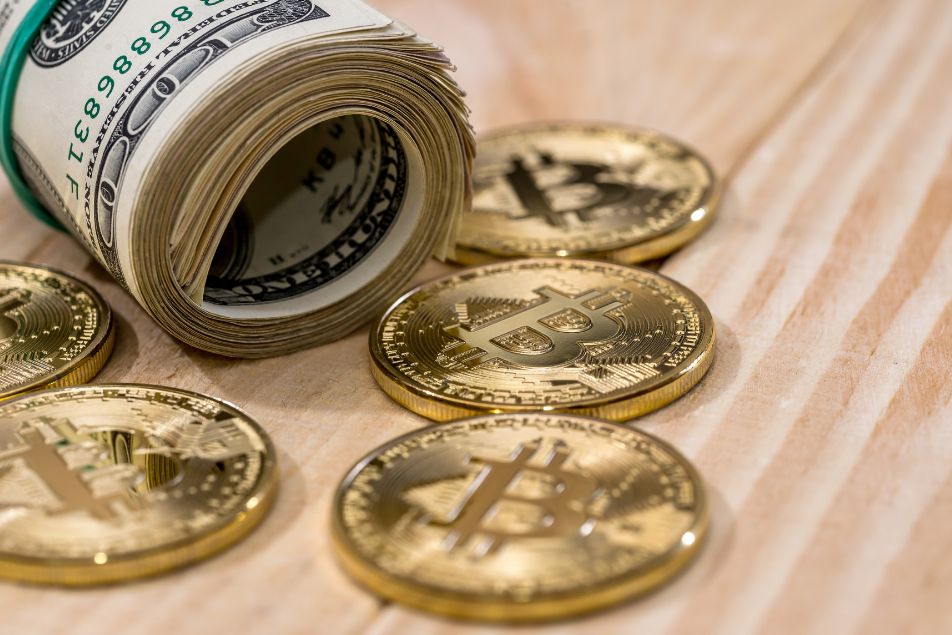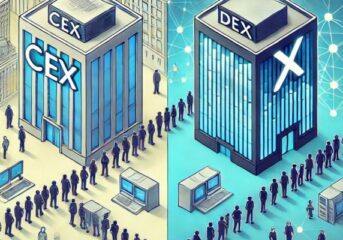Cryptocurrency vs Traditional Currency: Understanding the Key Differences
The growing popularity of cryptocurrency is sparking a global conversation about the future of money and a potential shift away from traditional fiat currency. Understanding the advantages and disadvantages of each helps you equip yourself as an investor to make more informed decisions with your finances. As digital currencies like Bitcoin and Ethereum continue to grab the headlines, it’s time to explore the differences between cryptocurrency and traditional currency.

What is Traditional Currency?
Traditional Currency Definition and History
Traditional currency, also referred to as fiat, is government-issued money used as a medium of exchange, store of value, or unit of account.
Historically, the value of a country’s currency was backed by a fixed amount of gold. This ‘gold standard’ meant paper money could freely be exchanged for gold. Over the last century, this system was largely abandoned, including in the United States in 1971.
Now, fiat money gets its value from supply and demand along with the stability of the government.
Governments print paper money, and the citizens must trust that it is worth using to pay for goods and services. It is up to the government to ensure stability and maintain value.
How Do Traditional Currencies Work?
Central banks and governments regulate and manage traditional currency, including the supply and monetary policy, to enable control of the economy.
Commonly this is done using quantitative easing and interest rates. Quantitative easing is when central banks print new money and inject it into the economy, often coupled with lowering interest rates so commercial banks can borrow money at cheaper rates. This helps to stimulate spending. Or monetary flow is tightened by turning off the money printers and raising interest rates to reduce the amount of borrowing in the economy.
The big problem to watch out for is inflation – this is a measure of how much the price of services and goods increases. It also reflects how much currency is being devalued. A small amount of inflation is considered positive. But when it gets out of hand and causes hyperinflation, currency becomes devalued leading to economic collapse.
To use traditional currency, people must use this centralized system of banks. Transactions require a bank or payment processor to act as a medium of exchange. Citizens must rely on governments and banks to manage the currency properly. Plus, they must adhere to the rules and regulations in place to partake in the system.
Types of Traditional Currencies
Coins and Banknotes
These are physical forms of money that can be exchanged in a peer-to-peer fashion. That means the holder of a coin or banknote can exchange it directly for goods and services without an intermediary.
Bank Deposits
This is the money held in a bank account. You trust a 3rd party bank to store your funds. The value is often represented in a numeric format. You can withdraw coins and banknotes from your account.
Electronic Money
Credit cards, Fintech apps, and payment systems allow you to pay for goods and services electronically. With the click of a button or tap of a card, you can transfer money from one person to another. This requires bank accounts for the sender and receiver along with 3rd party payment processors and technology.
What is Cryptocurrency?
Cryptocurrency Definition and History
Cryptocurrency is a digital form of currency based on cryptography. It uses a digital ledger to record the ownership of each coin and computers to verify transactions. Cryptocurrency operates without the control of a central bank or government. This is known as decentralization – a much-loved feature of crypto.
It is designed to be peer-to-peer, so people can transfer funds from one person to another without the need for a middleman, payment processor, or bank. All you need is a computer and an internet connection to complete a transaction in seconds.
How cryptocurrencies function using blockchain technology
Blockchain technology is a secure distributed network using cryptography to store data. The blockchain stores a record or ‘ledger’ of all transactions made on the network.
The network is made up of hundreds or thousands of computers, known as nodes. These computers can be spread out across the world and are used to validate transactions and maintain the accuracy of the ledger. Transaction data is placed into blocks, processed by nodes, and added to the network. It’s a chain of data blocks, hence the name blockchain. The data on these blockchains can’t be deleted, edited, or forged once confirmed. Plus, the ledger is publicly available for complete transparency.
When one person sends cryptocurrency to another, the transaction is recorded forever in the blockchain. You can’t add counterfeit or unaccounted-for money to the system as the transaction would be rejected by the validator nodes.
Types of Cryptocurrencies
Payment Coins
The first cryptocurrencies like Bitcoin and Litecoin were designed solely for payments – a medium of exchange over the internet. Users can hold them in a crypto wallet, send, and receive them. Plus use them to pay transaction fees on the blockchain.
Utility Tokens
With more advanced blockchains came the need for cryptocurrencies that have more functionality. Often these are second-layer tokens built into applications running on a blockchain. For example, the MakerDAO lending application has two cryptocurrencies in operation. DAI is used as a payment currency and MKR is used as a governance token giving holders the right to vote on governance decisions for the project.
Stablecoins
Stablecoins maintain a stable value and are ‘pegged’ to another reserve asset. The two largest stablecoins, USDT and USDC, are pegged 1:1 to the US Dollar. This means 1 USDT is always worth $1. They are useful as a trading pair, a stable store of value, and act as a ‘digital dollar.’
Centralized Cryptocurrencies
Some governments have developed their own cryptocurrencies, Central Bank Digital Currencies (CBDCs). Although these use blockchain technology, they are controlled and managed by a central organization. This could be useful in the digital world but faces backlash in the decentralized cryptocurrency community.
With more advanced blockchains came the need for cryptocurrencies that have more functionality. Often these are second-layer tokens built into applications running on a blockchain. For example, the MakerDAO lending application has two cryptocurrencies in operation. DAI is used as a payment currency and MKR is used as a governance token giving holders the right to vote on governance decisions for the project.
Stablecoins
Stablecoins maintain a stable value and are ‘pegged’ to another reserve asset. The two largest stablecoins, USDT and USDC, are pegged 1:1 to the US Dollar. This means 1USDT is always worth $1. They are useful as a trading pair, a stable store of value, and act as a ‘digital dollar.’
Centralized Cryptocurrency
Some Governments have developed their own cryptocurrencies. Although they use blockchain technology, they are controlled and managed by a central organization. This could be useful in the digital world but faces backlash in the decentralized cryptocurrency community.
Key Differences Between Cryptocurrency and Traditional Currency
Centralization vs Decentralization
Traditional currency is centralized, controlled by governments and central banks. Cryptocurrency is decentralized operating on predetermined code and maintained using peer-to-peer networks with no central authority.
Value and Inflation
Traditional currency suffers from inflation, and governments tend to prefer inflation as it helps to stimulate and grow the economy. But it means money loses its value, so goods and services become more expensive over time.
Cryptocurrency value is determined by market supply and demand. Some have fixed total supply (like Bitcoin), while others have infinite supply. New coins are minted to the network based on protocols, not economic factors. Often, cryptocurrency developers aim for a deflationary currency, meaning it increases in value over time as supply reduces and demand grows.
Security Features Compared
Traditional currency relies on physical security measures like watermarks, holograms, and bank vaults. It requires oversight of banks and governments to protect against counterfeit money, theft, and cyber attacks.
Cryptocurrency is secured using cryptography, which is hard to hack and resistant to counterfeiting. The strongest blockchain networks are resistant to malicious actors as there is no single point of failure to attack. Users can store crypto in a ‘self-custody’ wallet so they have complete control of their funds. While the blockchain is secure, wallet security can be compromised by hackers.
Regulation and Legal Considerations
Traditional currency is heavily regulated, and rules are becoming ever tighter. This is because governments want to ensure the stability of their currency, as well as catch criminals and take away their sources of funding from money laundering, tax evasion, and proceeds of crime.
Cryptocurrency regulation varies around the world including complete bans in some jurisdictions. Although, a few countries, like El Salvador, are embracing crypto now. Developed nations tend to have strict crypto regulations just like their rules for traditional finance, to control and monitor its use. However, innovative decentralized finance (DeFi ) platforms and products still sit in legal grey areas. Governments rarely declare cryptocurrency as legal tender.
Transaction Speed and Cost
With traditional payment methods transactions can be painfully slow and expensive, especially for cross-border transactions. Even Visa and Mastercard transactions can take 3 – 5 days to clear, while users face high fees for currency conversions although these are often hidden within the product or service pricing.
Cryptocurrency is faster and cheaper, especially newer payment coins which complete in less than a second at almost no cost. Older cryptos like Bitcoin do have some issues with speed and cost during busy network periods but still complete in minutes or hours.
Accessibility and Usability
Traditional currency is widely accepted and is used to pay for most goods and services. However, in developing nations, many adults are still ‘unbanked’ and don’t have proper access to the financial system. Citizens must go through extensive identity checks to access banking systems.
Cryptocurrency is still not widely accepted by merchants. However, platforms like Bitpay make it possible to pay bills and shop online with crypto. Cryptocurrency is highly accessible, enabling anyone to use the system without documentation or ID checks.
Advantages and Disadvantages of Cryptocurrency
Advantages
- Decentralization removes the need to trust a central organization or government that could interfere with or manipulate the value of the currency, or exclude people from the system.
- Transaction speed is fast, taking less than a second in many instances.
- Fees are low, allowing people to transact for a fraction of a penny.
- Hedge against inflation is a commonly touted benefit, particularly in unstable countries with hyperinflation.
Disadvantages
- Volatility is a problem as the value of coins can change dramatically in minutes due to supply and demand.
- Acceptance of crypto is still growing; most merchants don’t accept it as payment.
- Regulation restricts and even illegalizes cryptocurrency in some countries, making it risky to use.
- Protection isn’t available for consumers so any loss, mistakes, or thefts are not covered by banking regulations.
Advantages and Disadvantages of Traditional Currency
Advantages
- Acceptance of traditional currency is huge, with virtually every merchant accepting it for goods and services.
- Protections are available for consumers on their funds. If banks fail or funds are stolen, you can be compensated for the loss.
- Flexible monetary policy enables governments and banks to react to economic situations.
- Stable value builds trust in using traditional currency without fear that it might lose buying power quickly.
Disadvantages
- High fees plague traditional finance, especially with cross-border transactions.
- Slow processing times lead to transactions taking days to complete as funds pass through multiple middlemen.
- Government interference can lead to monetary policy mistakes, manipulation, and economic instability.
- Trust is required for third-party banks and payment processes to handle money correctly.
The Future of Money: Cryptocurrency or Traditional Currency?
Our CoinHint analysts are of the opinion that traditional currency isn’t disappearing anytime soon. It remains the backbone of the global economy, and the US Dollar is still considered the world’s reserve currency. That being said, at times, the currency financial system can feel antiquated, especially when payments take days to complete and incur excessive fees.
The future of money will likely involve a hybrid system where traditional and digital currencies coexist. There could be heavy use of stablecoins for digital payments in the future, especially to make cross-border payments faster and cheaper. Plus, central banks are experimenting with digital currencies inspired by cryptocurrency.
FAQ
-
Can cryptocurrency replace traditional currency?
Cryptocurrency is unlikely to replace traditional currency in the near term. They will likely coexist in the future.
-
How Are Crypto and Fiat Currency Similar?
Both crypto and fiat currency operate as a medium of exchange, a store of value, and a unit of account. Plus both can now make digital transactions.
-
Is cryptocurrency more secure than traditional currency?
Cryptocurrency runs on cryptographic blockchain networks, which are highly secure and resistant to hacking with no single point of failure. Traditional currency offers more governmental protection of funds.
-
Why is Crypto So Volatile compared to Traditional currency?
Crypto is so volatile because of its relatively small user base and effect of supply and demand. It is still a speculative asset which means people sell and buy it depending on market trends.








